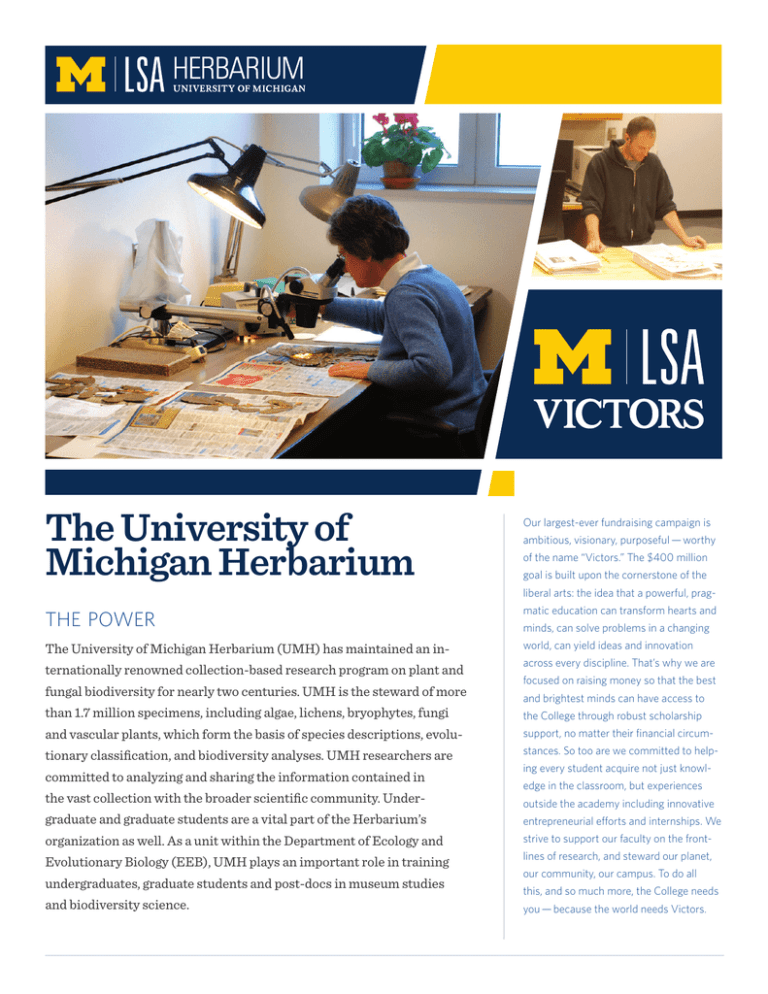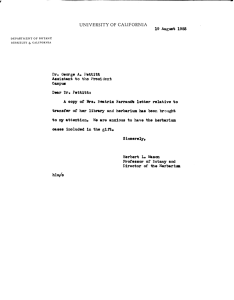The University of Michigan Herbarium
advertisement

The University of Michigan Herbarium Our largest-ever fundraising campaign is ambitious, visionary, purposeful — worthy of the name “Victors.” The $400 million goal is built upon the cornerstone of the liberal arts: the idea that a powerful, prag- the power matic education can transform hearts and The University of Michigan Herbarium (UMH) has maintained an in- world, can yield ideas and innovation ternationally renowned collection-based research program on plant and fungal biodiversity for nearly two centuries. UMH is the steward of more than 1.7 million specimens, including algae, lichens, bryophytes, fungi minds, can solve problems in a changing across every discipline. That’s why we are focused on raising money so that the best and brightest minds can have access to the College through robust scholarship and vascular plants, which form the basis of species descriptions, evolu- support, no matter their financial circum- tionary classification, and biodiversity analyses. UMH researchers are stances. So too are we committed to help- committed to analyzing and sharing the information contained in the vast collection with the broader scientific community. Undergraduate and graduate students are a vital part of the Herbarium’s organization as well. As a unit within the Department of Ecology and Evolutionary Biology (EEB), UMH plays an important role in training undergraduates, graduate students and post-docs in museum studies and biodiversity science. ing every student acquire not just knowledge in the classroom, but experiences outside the academy including innovative entrepreneurial efforts and internships. We strive to support our faculty on the frontlines of research, and steward our planet, our community, our campus. To do all this, and so much more, the College needs you — because the world needs Victors. the opportunities Students and researchers derive inestimable benefits from using the Herbarium’s collections to study firsthand the diversity of organisms from a wide variety of habitats and regions of the world. Students have the opportunity to work closely with faculty, curators, and collection managers and receive training in plant systematics, museum curation, lab research, and field research. Those working as museum assistants help with the preparation, shipping, and processing of specimens and also assist curators and collection managers with special projects. Students gain experience in herbarium and museum techniques and insight into the importance of museum collections for studies on plant diversity, ecology, evolution, and classification. The Herbarium has been instrumental in the careers of many leading biologists, both inside and outside academia, and is an essential component of the life sciences research and teaching at the University of Michigan. the impact In order to continue to grow and flourish, the Herbarium must be able to offer students—both undergraduate and graduate—opportunities to learn by experience through curatorial assistantships during the academic year and in the summer months. Awards for study for both faculty and students will also allow us to add to our collections and acquire more information from different sources, enhancing our department and the field at large. UNDERGRADUATE SUMMER CURATORIAL ASSISTANTSHIPS $30,000 annually / $5,000 per student Undergraduate engagement in biodiversity collection development is a vital part of the UMH’s educational mission and participants get training in the knowledge, skills and operational competencies required for research museum function. Working in collections exposes our students to the sheer diversity of life—thousands of species from all around the world—that can only be experienced in museums. Indeed, a number of leading biodiversity researchers have attributed their career choice to formative undergraduate experiences in university natural history collections. Our goal is to initiate a new program of summer assistantships that would enable undergraduates interested in plant and fungal biodiversity to have a fully immersive research museum experience. Such funding is especially important for those students who need to earn money for college during the summer and could not gain this important experience without a stipend. STRATEGIC FUND $10,000 to $50,000 annually Gifts of undesignated, expendable funds are particularly helpful in addressing emergent issues and opportunities for the UMH and its museum program. These funds can be used to initiate pilot research projects, obtain equipment for research and teaching, or partially fund field activities of students. FIELD STUDY AWARDS $5,000 to $10,000 annually Awards of varying amounts will be made to UMH curators, staff, and students who wish to focus attention on new specimen and data collection, whether in Michigan or in other geographical focal areas. The aim of this fund will be to support innovative approaches to incorporate new collections and associated information into informatic tools that will be quickly available to the public and scientific community to see and use. WAYS TO FUND YOUR GIFT Your gifts of cash, pledges, or appreciated securities change lives. Wills, estate, and planned gifts allow you to create a lasting legacy that will enable the best and brightest minds to experience a liberal arts education, solve problems in a changing world, and yield ideas and innovations that will make a difference in Michigan and around the globe. CONTACT INFO Development, Marketing, and Communications, College of LSA 500 South State Street, Ste 5000 Ann Arbor, Michigan 48109-1382 P.734.615.6333 F.734.647.3061 www.lsa.umich.edu www.lsa.umich.edu/herb

